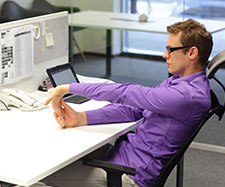Stronger and smarter: Fitness at work
 There are many benefits of an active lifestyle: decreased risks of cardiovascular disease; decreased risk of many cancers and other chronic illnesses; stronger immune systems; less stress and anxiety and more energy. Exercise also helps our brains work better, making us more productive at work and at home. But for those of us who mostly sit all day, even doing the recommended 30 minutes of vigorous exercise five times a week may not undo the health risks of our mostly sedentary life.
There are many benefits of an active lifestyle: decreased risks of cardiovascular disease; decreased risk of many cancers and other chronic illnesses; stronger immune systems; less stress and anxiety and more energy. Exercise also helps our brains work better, making us more productive at work and at home. But for those of us who mostly sit all day, even doing the recommended 30 minutes of vigorous exercise five times a week may not undo the health risks of our mostly sedentary life.
Try incorporating physical activity into your workday with short bouts of aerobics, strength exercises and stretches. For example:
- If you take public transit, get off a couple of stops early and walk the rest of the way. If you drive to work, park as far away from your building’s entrance as you can.
- If you’re fortunate to work close to a gym, try to use your lunch break to fit in a workout. Many large organizations subsidize their employee’s fitness fees and large gyms often offer corporate memberships.
- Ignore the elevators and take the stairs. Don’t let working on the 24th floor discourage you. Take the elevator to the 20th floor and walk the last four. Slowly increase the number of floors and your speed without stopping to catch your breath.
- Use your breaks to exercise:
- Walk or run up and down several flights of stairs. Slowly increase the number of floors and your pace.
- Jog one or two laps around your building.
- Get a few colleagues together and play hockey, soccer or basketball in the parking lot (clear it with HR first). Or simply go for walk.
- Do some yoga stretches, squats, lunges or wall sits in your cubicle. If this isn’t possible, use the large stall in the washroom. If no one is around, do pushups using the sink counter!
- Keep some light dumbbells and a resistance band in your desk and do some strength training exercises every time your eyes need a quick break from the computer screen.
- Sit up straight. Good posture reduces fatigue and strain on your ligaments, muscles, tendons and joints. Watching your posture can also alleviate neck and back pain as well as give your lungs the room to work efficiently – and provide your brain with more oxygen.
- Replace your chair with a stability ball. You’ll strengthen your abdominal muscles and improve your posture while working.
- Join or contact, your workplace health and wellness committee and organize lunch time yoga or stretch classes for all employees.
- If your employer offers standing desks, request one. Standing rather than sitting all day burns more calories, lowers blood sugar, reduces fatigue and, for many people, helps reduce upper back and neck pain.
- When waiting for that big print job to be completed or the boss to arrive, do some calf raises. Standing with feet shoulder-width apart, press up onto your tip toes, pause, and then lower back down. Repeat.
- Instead of calling or emailing a co-worker down the hall, walk to their desk.
Stay alert and focused
Study after study has shown that work performance is consistently higher after exercising – even a few minutes of yoga or a brisk walk does the trick. So protect your greatest asset – your brain – by incorporating movement into every aspect of your work day.
